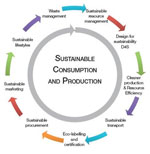

Idiomas:


In fact, circular economy is the result of moving from a simple impact reduction model to a model of absolute value creation that is positive, both socially, economically, environmentally and thus … thermodynamically.
In practice, the central element is the “decoupling” of economic growth from an increase in resource use and reduction of environmental impacts. For the Club of Rome report, there is indeed an urgent need for such decoupling between value creation and purely economic growth8 to ensure a transition to an integrated and circular economy. As a matter of facts, decoupling human well-being from resource consumption is indeed at the heart of the International Resource Panel’s (IRP) mandate of UNEP9 and of its Green Economy Initiative10.
According to the UNEP report, OECD seems to be the first international body to have adopted it in 2001 by defining decoupling as "breaking the link between environmental disadvantages and economic goods". The OECD work on green growth11 considers that “by reducing, reusing and recycling (the 3Rs) materials, we can decrease the need for virgin materials and improve resource efficiency. The challenge before us is to move towards a society where we create more value with less natural resource input, and where we do not compromise the needs of future generations”.
In this context, UNEP-Environment's functional definition of a green economy, without reference to growth, is an economy that translates into "improved human well-being and social equity, environmental risks and ecological shortages. In its simplest expression, a green economy can be seen as low carbon, resource efficient and socially inclusive" This being achieved through greater efficiency and reduced use of scarce resources and associated reduction of environmental impacts12.
The Club of Rome Report recommend thus that the EU policy must require by 2050:
To realize what concrete implementation of such a process see in particular the short animated educational videos published by the European Commission:
or also :
Designing strategies to decouple in practice the economic activity from its unsustainable environmental impacts therefore requires a fundamental evolution of our conceptions and our mentalities. Instead of concentrating, in a traditionally reductive approach, on a single problem at a time, it is indeed essential to be able to integrate simultaneously all the different dimensions implied by such decoupling and to adopt for this purpose a method of analysis which is truly systemic13.
Only such an ecosystemic approach would truly allow to maximize the value and resilience generated by the resources and energy available through the initiatives and the potential for innovation that would make this evolution possible. In the vision of the European Commission, the transition to a more circular economy requires changes along the value chains and here also, it is underlined that “this implies a complete systemic change and innovation, not only in technologies but also in the organization, society, financial methods and policies”14.
Among the benefits underlined in the EASAC report that could derive from a circular economy, which could align what we have with what we use, are:
8 Brief for GSDR 2015 Decoupling Growth from Resource Generation Niazi et al Development Alternatives* ![]()
9 ![]()
10 UNEP, 2011 Towards a Green Economy: Pathways to Sustainable Development and Poverty Eradication ![]()
11 Report “Resource Productivity in the G8 and the OECD” (2011): ![]()
12 http://staging.unep.org/greeneconomy/AboutGEI/WhatisGEI/tabid/29784/Default.aspx![]()
13 http://www.clubofrome.org/a-new-club-of-rome-study-on-th e-circular-economy-and-benefits-for-society/![]()
14 European Commission Towards a circular economy: A zero waste programme for Europe COM(2014) 398 final pg ![]()

This summary is free and ad-free, as is all of our content. You can help us remain free and independant as well as to develop new ways to communicate science by becoming a Patron!